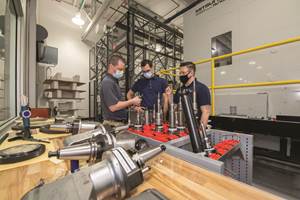Hollow Workpiece? Try Hollow Barstock
A video from Sandvik Materials Technology demonstrates the benefits of turning oilfield parts out of near-net-shape rather than solid barstock.
It’s not easy to get excited about barstock. As flashy and interesting as the How-It’s-Made-style computer animation of the metallurgy process is, at the end of the day what you’re left looking at is an inert cylinder of duplex stainless steel. Except it has a hole in it. Which is where it gets interesting, because according to Sandvik Materials Technologies, starting off with a bore in the barstock can double or even triple productivity for turning certain hollow workpieces.
The company’s line of hollow bar is offered as part of the latest iteration of its Sanmac stainless steel material. The material is available in a range of grades said to be machinable at similar rates to carbon steel. Bars can be ordered with varying dimensions, ranging from as small as an OD of 1¼ inches and an ID of ¾ inch (32 and 20 mm, respectively), to as large as an OD of 10.83 inches and an ID of 7¾ inches (275 and 200 mm, respectively).
Viktor Stefansson, global product manager, who mentioned to me in passing that this sort of hollow barstock is well-known in Europe in contrast to the United States, explains that in the past, machinists shifting from machining carbon steel to stainless steel had to slow down their machining speeds and alter other setting to avoid issues like frequent vibration, chatter, gumming up on the cutting tools and poor chip breaking behaviors. He says that the Sanmac barstock’s material consistency enables machining speeds of 240 meters per minute.
Of course, using near-net-shape stock provides a number of immediate potential benefits by simply taking a chunk of the object’s mass out of the picture: less machine energy consumption, less actual cutting (which means less tool wear, less lube, and fewer chips to dispose of) and faster cycle times. Product Manager Dave Shollock adds that hollow bar eliminates the need for trepanning in the case of components with central bores. Trepanning can cause the material to work harden, causing problems to solve in subsequent machining operations, he says.
According to Sandvik, Sanmac bar is particularly suited to the manufacture of mechanical seals, valve bodies, flow meteres, pumps and other oilfield components. Executive Editor Derek Korn has reported on Sandvik’s Sanmac stainless steel material in the past, specifically concerning a duplex stainless ball valve seat for an oilfield valve assembly. More recently, Sandvik released a video showing a side-by-side comparison of a similar application involving the hub of a pump assembly.
In the video, both sides of the split screen show the turning process for the same hub part, but with the catch that the one on the left uses solid duplex stainless steel barstock, while the one on the right uses the hollow version of the same grade. It’s an impressive demonstration of the hollow bar’s potential benefits, tripling productivity in the case of this part. (You could say it’s enough to get excited about.)
But for the less excitable, more sober-minded prospective barstock buyer, Sandvik has provided a way to get more specific concerning the quantitative benefits of switching to hollow bar. The Bar Converter accessible on the company’s website enables a user to input data about a given part’s steel grade, finished diameters, length, number of parts per production series and the user’s current approximate cost for solid barstock. The converter then displays an expected cost savings from switching to the appropriate hollow-bar substitute.
Related Content
Deep Hole Drilling Without Drift
A deep hole drill with intuitive controls and minimal hole drift was one shop's pipe dream — until the shop helped a machine tool builder make it.
Read MoreDigital Twins Give CNC Machining a Head Start
Model-based manufacturing and the digital thread enable Sikorsky to reduce lead times by machining helicopter components before designs are finalized.
Read MoreHow to Start a Swiss Machining Department From Scratch
When Shamrock Precision needed to cut production time of its bread-and-butter parts in half, it turned to a new type of machine tool and a new CAM system. Here’s how the company succeeded, despite the newness of it all.
Read MoreChoosing Your Carbide Grade: A Guide
Without an international standard for designating carbide grades or application ranges, users must rely on relative judgments and background knowledge for success.
Read MoreRead Next
3 Mistakes That Cause CNC Programs to Fail
Despite enhancements to manufacturing technology, there are still issues today that can cause programs to fail. These failures can cause lost time, scrapped parts, damaged machines and even injured operators.
Read MoreThe Cut Scene: The Finer Details of Large-Format Machining
Small details and features can have an outsized impact on large parts, such as Barbco’s collapsible utility drill head.
Read More







.jpg;maxWidth=300;quality=90)

.jpg;maxWidth=300;quality=90)







.png;maxWidth=300;quality=90)








